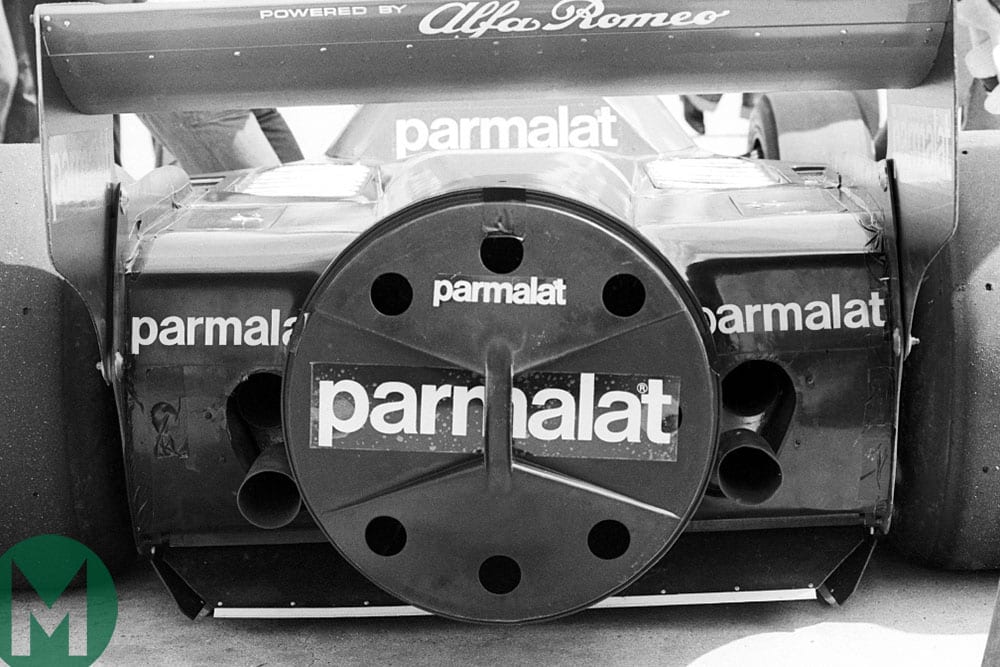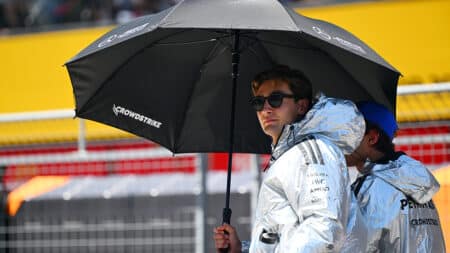
2025 is F1’s most polite title battle ever – Up/Down in Austria
Describing this year's championship race as a 'battle' might be slightly over-egging it, writes James Elson
In this extract from his new book, One Formula, 50 years of car design, legendary F1 designer Gordon Murray looks back at one of his most famous creations, the Brabham BT46B.

Niki Lauda and John Watson at the wheel of the Brabham BT46B. Photo: Motorsport Images
If you’re looking for an example of the ingenious and outlandish thinking that F1 breeds, then the Brabham fan car remains a stand-out example, forty years after it appeared.
It may have only raced once – when it won – but the story of its development and demise, as told by its designer, Gordon Murray, illustrates the creativity, inventiveness and politics of Formula 1 in the 1970s.
Bernie Ecclestone and Murray went into the 1978 F1 season with their sights set on the world championship.
The Brabham team owner and its chief designer knew that their BT46 car was fast and could count on the pace of Niki Lauda and John Watson.
But their hope was rapidly extinguished by Colin Chapman’s Lotus 78, which employed ground effect and took four victories from the first seven races of the season.
Murray was working on a redesign to save Brabham’s season but faced a sizeable problem in the shape of the car’s flat 12 Alfa Romeo engine. Unlike the V8s of rivals, the engine’s cylinder heads poked out just at the point where the car would need a Venturi to pull air into the rear diffuser. He would need a different solution.
In an extract from Murray’s latest book, the designer explains how he came up with the concept that would become the infamous fan car.
“I read the regulations again and Article 3.7 on aerodynamic devices said, ‘Anything that’s primary function is to have an aerodynamic influence on the car must always remain stationary and be fixed relative to the sprung mass of the car’. I spoke to a lawyer friend, and said, ‘What does primary function mean?’ and he said, ‘Well, how many functions are there?’ I said, ‘Two’. So he said, ‘The primary function is the one that has more than half the influence.’
“So if we could get [side] skirts to seal like the Lotus ones and have a cooling fan that uses more than 50 percent of its flow to cool the car and the rest to suck the car down…
“A lot of stuff has been written that says we tried to hide the fact that it was sucking the car down. We didn’t. We always said, ’It sucks the car down, but that’s not its primary function. Its primary function is cooling.’
“The one thing that’s been completely misreported in all the books and magazines is that the car was banned. It was never banned.”
“The biggest problem by a mile was sealing the skirts. We could tune how hard it pushed into the ground because if you had too much spring on the skirts the sacrificial wearing strip would wear out before the end of the race, and you’d had it, basically. If you had it too loose, the suction from the fan working on the inside of the skirt would lift them up and you would lose the seal. So, we just tuned and practised with these at Brands Hatch and Balocco in Italy.
“The only problem was that [the drivers] wouldn’t know if they had damaged the skirt. They could go into a corner 30mph too fast and then have no suction and go flying straight on. So, David went down to a scrapyard and got an altimeter out of an old aeroplane. We had a pitot tube on the front, which you can see in all the photographs, which measured the static pressure. All an altimeter does to read the altitude is measure static pressure and local pressure, and it uses the pressure differential to calculate the height. So that’s what we did. We had this altimeter tie-wrapped in the cockpit, right in front of the driver, with a green zone and a red zone. We said, “Forget the numbers; that’s nothing to do with it. If you’re coming into a corner, the needle has to be in the green zone. If it’s in the red zone, you’ve lost suction. Slow down.”

Bin lid cover for fan Photo: Motorsport Images
“People were photographing the fan blades, so the mechanics found a dustbin lid, which fitted perfectly! We were so fast, Bernie didn’t want to piss everybody off completely so he made the drivers qualify on full tanks.”
In spite of this, Watson shared the front row with pole man Andretti in a Lotus 79. Lauda was third fastest, with the other 79 of Peterson for company. ”Of course, the rest is history. We won the race.”
That amazing victory in Sweden was the BT46B’s one and only race but, as Gordon puts it, ”the one thing that’s been completely misreported in all the books and magazines is that the car was banned. It was never banned.
“I have still got the letter from the CSI, the ruling technical body in those days. I had explained already to the scrutineers that more than 50 percent went through the radiator and the rest of it sucked the car down; I wasn’t trying to hide it. So they came to the factory with an anemometer and they got us to go up through the revs – 5,000, 6,000 – and then measured the air through the fan and the air through the radiator. They got more than 55 percent of the air going through the radiator and wrote me a letter that said, ‘It’s absolutely legal. You can run it until the end of the year, but then we will close the loophole.’

Lauda leads from Watson Photo: Motorsport Images
“It was Bernie that came to me and asked me to withdraw the car because he was being put under massive pressure from Chapman and Tyrrell and the other constructors. Bernie was just getting powerful in Formula 1, and they said, ‘If you carry on racing that car, that’s the end of the Formula One Constructors Association. You can forget it; we are walking away from it.’
“It was all led by Chapman. We would have won every race and he could see his Championship flying out of the window. He got Andretti to go round and tell the other drivers the thing was throwing stones out. It never threw stones out; the fan efflux was 55mph. It was never throwing dust or stones anywhere. Chapman told Andretti to go round saying it was dangerous, it should be banned. When he didn’t win that argument, he got the constructors together and said, ‘If they don’t take that thing off the road, we’ll just ban them from the Constructors’ Association.’ So, Bernie came to me and asked me to scrap the car.
“He was looking at the bigger picture, for sure, otherwise he would have just said, ‘We’re going to win the Championship.’”
This extract is taken from Murray’s book, One Formula, 50 years of car design, which includes the full story of the fan car’s development including the delicate calibration of suspension and skirts, as well as the inventive solutions that ensured that it wouldn’t self-destruct under full power from the engine at the start.
The book is a two-volume tale of his five decades in car design, detailing the innovations and challenges of more than 70 road and racing cars from the early days at Brabham to the McLaren F1 and Mercedes SLR.
In the Motor Sport review, Gordon Cruickshank describes the book as ”handsomely produced (and reproduced). It’s a book for those who appreciate engineering, ingenuity and sheer rule-stretching chutzpah from a design maverick”.

Describing this year's championship race as a 'battle' might be slightly over-egging it, writes James Elson

You had to read between the lines at the 2025 Austrian Grand Prix as George Russell dropped hints over about his dissatisfaction, and F1 sent a message to FIA president Mohammed Ben Sulayem

From zero to hero: in a pacy McLaren, at one of his favourite F1 circuits, Lando Norris picked himself up from a disastrous Canadian race to reign supreme in the 2025 Austrian Grand Prix

Full F1 schedule for the year, including the next F1 race of 2025: the British Grand Prix at Silverstone, the whole calendar and circuit guides for the 24-race Formula 1 season